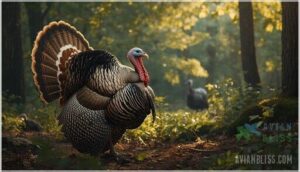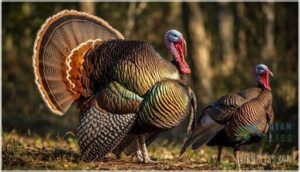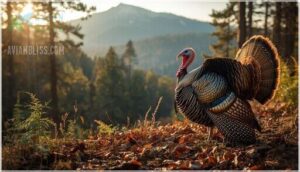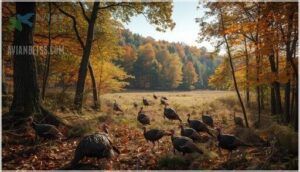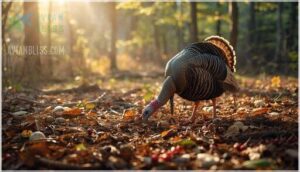This site is supported by our readers. We may earn a commission, at no cost to you, if you purchase through links.
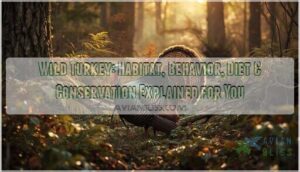
Yet, wild turkeys are more than a flash of iridescent feathers; they’re masters of adaptation, thriving everywhere from deep woodlands to the edge of suburbia. If knowing what makes a wild turkey tick seems a bit mysterious, you’re about to see why this bird is more fascinating than its reputation lets on.
Table Of Contents
- Key Takeaways
- Wild Turkey Identification and Classification
- Wild Turkey Habitat and Distribution
- Wild Turkey Behavior and Life Cycle
- Wild Turkey Diet and Foraging Habits
- Conservation Status and Population Trends
- Frequently Asked Questions (FAQs)
- Is wild turkey a bourbon or whiskey?
- Are wild turkeys OK to eat?
- What attracts wild turkeys?
- What is the difference between a turkey vulture and a wild turkey?
- How does climate change impact wild turkeys?
- What subspecies are living in suburban areas?
- How do wild turkeys adapt to snowy conditions?
- What factors influence wild turkey population dynamics?
- How has artwork depicted wild turkeys historically?
- How do you observe wild turkeys safely in nature?
- Conclusion
Key Takeaways
- Wild turkeys are highly adaptable birds, thriving in forests, fields, and even suburban areas thanks to their flexible behaviors and diverse diets.
- These birds are easy to recognize by their shimmering metallic feathers, dramatic tail fans, and the striking differences between males and females.
- Wild turkey populations once crashed to near extinction but have made a remarkable comeback through focused conservation and habitat restoration efforts.
- Climate change and habitat fragmentation still challenge wild turkeys, demanding ongoing, science-based conservation strategies to keep their flocks healthy.
Wild Turkey Identification and Classification
Before you spot a wild turkey in the field, it helps to know what sets them apart. Here’s a quick look at their scientific names, eye-catching features, and the regional differences you might notice.
Let’s break down what makes these birds unique.
Scientific Name and Taxonomy
Let’s talk formal scientific names. Wild turkeys belong to the genus Meleagris and the species gallopavo, making Meleagris gallopavo their avian identity. Taxonomic authorities recognize multiple turkey subspecies, highlighting the bird’s rich diversity.
Closest relations? Look to the ocellated turkey. Understanding these details gives you a peek into wild turkey characteristics and bird relationships.
These birds are native to North America and represent an American icon.
Physical Appearance and Distinctive Features
Wild turkeys strut their stuff with some showstopping looks—picture metallic feathers that catch the sun (that’s plumage iridescence), dramatic shifts in head coloration, and several size variations between the sexes (sexual dimorphism). You’ll notice:
- Glossy bronze wings and bold tail fans
- Males’ impressive beards and sharp spurs
- Iridescent feathers and distinct feather adaptations
Wild turkey characteristics always leave an impression. Some even display unique color variations.
Subspecies and Regional Variations
You’ll spot wild turkey species in all sorts of landscapes, thanks to five main subspecies. The Eastern Turkey rules broad forests, Osceola Turkeys stick to Florida swamps, Rio Grande birds claim prairie land, while Merriams Turkey likes mountain forests. Goulds Turkey roams rugged Southwest peaks.
Here’s a quick look:
| Subspecies | Primary Habitat |
|---|---|
| Eastern, Osceola | Forests, Swamps |
| Rio, Merriams, Goulds | Prairies, Mountains |
Wild Turkey Habitat and Distribution
If you’re curious where wild turkeys make themselves at home, you’re in the right place. Their story stretches across all kinds of landscapes and climates. Up next, let’s look at the different environments they call their own.
Natural Range Across North America
If you picture a map of North America, the wild turkey’s range stretches wider than ever before, touching nearly every U.S. state—except Alaska—and reaching into southern Canada and even central Mexico.
Range expansion has taken root thanks to habitat suitability and shifting environmental limits, creating thriving populations that adapt to regional habitat and subspecies distribution patterns.
Preferred Ecosystems and Habitats
Across the landscape, wild turkey habitats are a clever patchwork: forests, field openings, riparian zones, and even savanna restoration sites all play a role. Turkey thrive where forest management keeps woodlands patchy but connected. Their favorite ecosystems include:
- Mixed hardwood forests
- Pine or oak savannas
- Streamside riparian zones
- Early-successional field openings
- Woodland-agricultural habitat mosaics
Adaptation to Human-Altered Environments
Although you might think wild turkeys stick to forests, their knack for urban colonization is impressive. They’ve shaped flexible foraging strategies and bold behavioral changes, thriving in suburban areas and weaving into local social structures.
These adaptations have real conservation implications, challenging old ideas about turkey habitat, behavior, and diet, and offering valuable lessons for managing wildlife in changing environments.
Wild Turkey Behavior and Life Cycle
Wild turkeys are more social and complex than they first appear. From courtship displays to roosting routines, there’s a lot happening behind the scenes. Here’s a closer look at how their daily lives unfold.
Social Structure and Flock Dynamics
Ever seen a crowd where everyone knows their place? That’s a wild turkey flock—dominated by strict dominance hierarchies and shifting flock composition that change with the seasons.
Different ages and sexes mingle or split up as needed, using clever communication methods to recognize each other.
Kin-based behaviors often show up, too, especially when foraging together improves everyone’s odds in their complex habitat.
Courtship, Mating, and Nesting Habits
Curious how wild turkey romance works? You’ll spot toms strutting and gobbling—classic courtship rituals meant to impress hens. These Gobbling displays start the drama, but the real story unfolds in five steps:
- Courtship displays
- Polygynous mating system
- Careful reproductive timing
- Larger clutch size (10–12 eggs)
- Nesting behavior impacting success
Wild turkey reproduction is truly fascinating.
Seasonal Movements and Roosting Patterns
Consider this: every season, wild turkeys play musical chairs with their habitats. You’ll notice their roost site selection changes—tree roosts in safer spots during winter and near water or roads in summer.
Foraging and daily travel distances spike during breeding season, while anti-predation roosts and seasonal range shifts help keep the whole flock safe and well-fed.
Wild Turkey Diet and Foraging Habits
Wild turkeys are surprisingly flexible regarding what they eat and how they hunt for it. Their menu shifts through the year and even from place to place.
Here’s how their food choices and daily routines stack up.
Primary Plant Foods and Seeds
Think of a wild turkey’s diet like a changing buffet—a rich mix that highlights diet diversity and seasonal shifts. Acorns, seeds from oaks and pines, and nutty mast are critical food sources, especially for energy during colder months.
They’ll also forage grain crops, grass seeds, and plant material, making seed viability and mast importance central to the turkey diet each season.
Animal-Based Foods and Seasonal Changes
As the wild turkey diet shifts with the seasons, insect protein and invertebrate consumption really ramp up in spring and summer. They snack on:
- Insects and spiders for protein
- Beetles, ants, and even snails for nutrients
- Amphibians in moist spots
- More invertebrates in the south, less in winter up north
- Animal foods help turkey diet and digestion year-round
Feeding Strategies and Daily Activity
After filling up on protein from summer insects, you’ll see their turkey foraging habits shift to fit the season. Ground feeding peaks in quiet mornings and late afternoons at familiar foraging locations—open fields, forest edges, and roadsides.
Brood foraging gets intense after sunrise. Grit consumption—small gravel—lets turkeys break down seeds, making their seasonal diet work year-round.
Conservation Status and Population Trends
It’s easy to forget that wild turkeys weren’t always so common on the landscape. Let’s take a look at how their numbers have changed over time, and what’s being done to keep those flocks healthy.
Here’s what you need to know about their conservation status and where their population stands today.
Historical Population Decline and Recovery
While wild turkeys once roamed in Early Abundance, the Population Bottleneck of the early 1900s nearly wiped them out. Thanks to Restoration Methods like reintroduction programs and habitat restoration, along with new Hunting Regulations, wild turkey conservation led to a strong turkey population rebound. Still, Current Fluctuations remind us how essential conservation efforts remain.
After near extinction in the early 1900s, wild turkeys rebounded powerfully thanks to restoration efforts and ongoing conservation
Here are the key stages in the wild turkey’s journey:
- Early Abundance: Turkeys were common across much of North America before European settlers arrived.
- Population Bottleneck: By the early 1900s, only about 200,000 turkeys remained, their habitats decimated, and hunting unregulated.
- Restoration Methods: Scientists and wildlife agencies pioneered trap-and-transfer efforts, moving turkeys from thriving populations to new locations.
- Hunting Regulations: Laws limited harvests and protected breeding birds, giving populations a chance to bounce back.
- Turkey Population Rebound: By the early 2000s, there were over 6 million wild turkeys, one of the most notable comebacks in conservation history.
Current Conservation Initiatives
Today, wild turkey conservation is all about teamwork and innovation. Habitat restoration—like prescribed fires and riparian projects—boosts nesting and brood sites.
Population monitoring uses GPS tagging, community science, and new data tools.
Modern stewardship models link states, nonprofits, and outdoor brands.
You can see these conservation efforts pay off, with reintroduction programs and ecological focus driving real results across turkey country.
Ongoing Threats and Management Strategies
Although conservation efforts for wild turkeys have made great strides, ongoing threats like habitat fragmentation and disease outbreaks still challenge turkey survival strategies.
Adaptive management, from adjusting hunting regulations to active predation control and habitat restoration, remains essential.
To protect flocks and keep this bird thriving, you need flexible, science-backed approaches that evolve as predators, disease, and landscapes change.
Frequently Asked Questions (FAQs)
Is wild turkey a bourbon or whiskey?
Bourbon vs Whiskey isn’t just a matter of taste—it’s about Production Standards, Mash Bill, Aging Process, and strict Legal Requirements.
Wild Turkey qualifies as a bourbon, meeting all standards set in Kentucky for this classic whiskey.
Are wild turkeys OK to eat?
You can eat wild turkeys, but there are some things to keep in mind. Cooking safety matters—reach 165°F to kill parasites and diseases. Lead contamination is a concern, so trim wound meat.
Wild turkey’s nutritional benefits make it worth considering.
What attracts wild turkeys?
Wild turkeys are drawn to places offering rich food sources like seeds, insects, and berries, easy water access, secure roosting sites, and good nesting cover.
Habitat management, like brushy thickets or targeted bird feeders, boosts your odds of attracting them.
What is the difference between a turkey vulture and a wild turkey?
It’s almost funny—turkey vultures and wild turkeys only share a name. Turkey vultures soar gracefully and scavenge, while wild turkeys stick to the ground, thrive in flocks, gobble loudly, and feast on seeds, bugs, or berries.
How does climate change impact wild turkeys?
Climate change stirs the pot for turkeys, tweaking habitat suitability, limiting food availability, and shifting behavioral trends. Extreme weather can spoil nesting success and survival, while unpredictable conditions challenge their diet, movement, and long-term conservation across North America.
What subspecies are living in suburban areas?
Suburban subspecies ID points to the Eastern wild turkey as most common, but you’ll also spot Merriam’s, Rio Grande, and Osceola in certain regions.
Urban adaptation drives population growth, avian habitat shifts, and, yes, more human conflict.
How do wild turkeys adapt to snowy conditions?
Snow Roosting helps turkeys survive bitter nights, while their Feather Insulation keeps them warm. Through Cold Adaptation, they conserve energy, shift to Winter Foraging in fields, and Flock Behavior boosts survival in challenging Wild Turkey habitat.
What factors influence wild turkey population dynamics?
Just like a finely balanced scale, turkey population dynamics tip with shifts in Wild Turkey habitat, habitat fragmentation, predation pressure, disease prevalence, and poult survival.
Reproductive success, foraging strategies, and Conservation efforts shape Wild Turkey behavior and future numbers.
How has artwork depicted wild turkeys historically?
Artwork has shown wild turkeys as icons of North America—ranging from Pre-Columbian Art and Native Symbolism, to European Illustrations, realistic Audubon Paintings, and Wildlife Photography—capturing turkey behavior, avian species traits, and Thanksgiving tradition.
How do you observe wild turkeys safely in nature?
For safe viewing tips, blend in with neutral clothes, keep at least 25 yards away, and use quiet gear.
Respect observation ethics: don’t feed turkeys, watch for stress signs, and stay mindful of wild turkey behavior and habitat selection.
Conclusion
If you ever find yourself out before sunrise, keep your eyes peeled—you might catch a wild turkey making its way through the shadows, as sly as a fox. This bird’s story is about resilience: from its shimmering feathers to its knack for survival among humans, it’s clear wild turkeys aren’t just surviving, they’re thriving.
Remember, every forest has a story, and sometimes it struts by on strong legs, echoing a legacy worth noticing and protecting.

